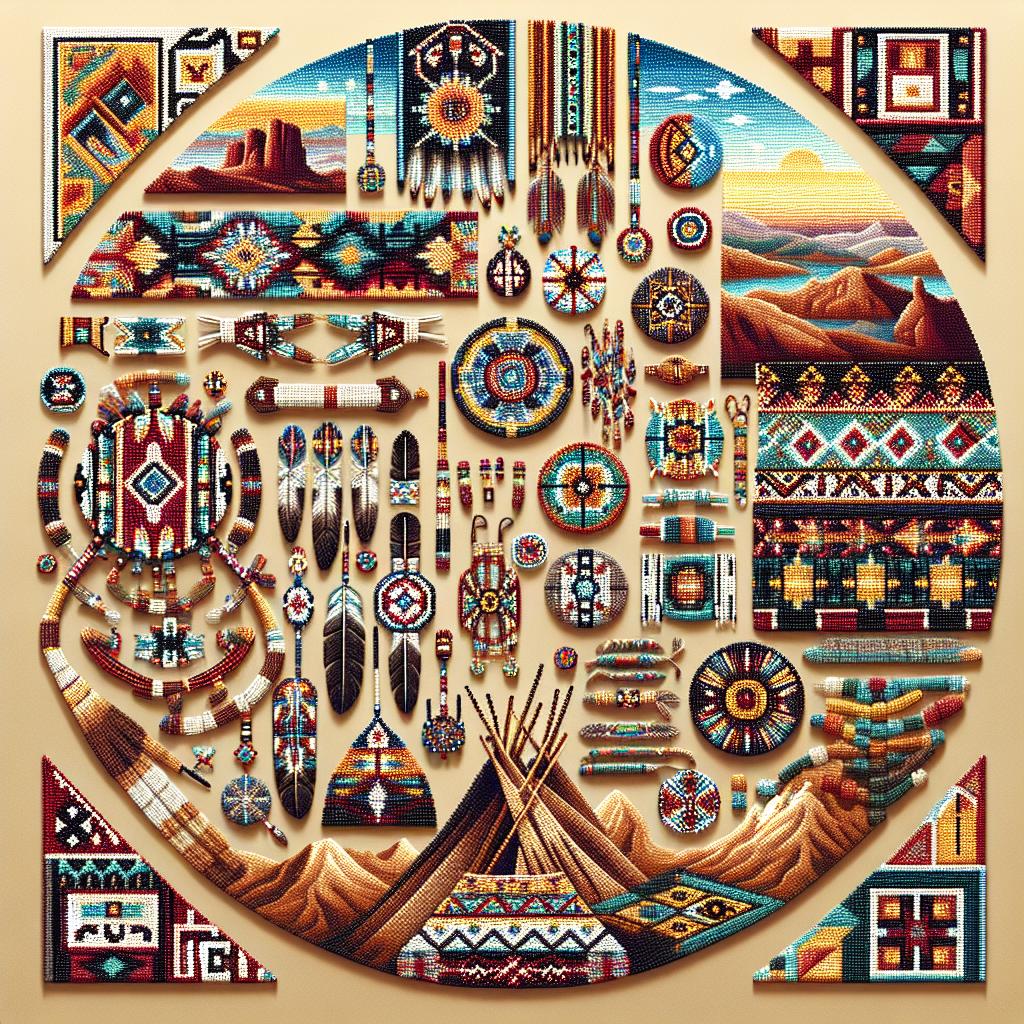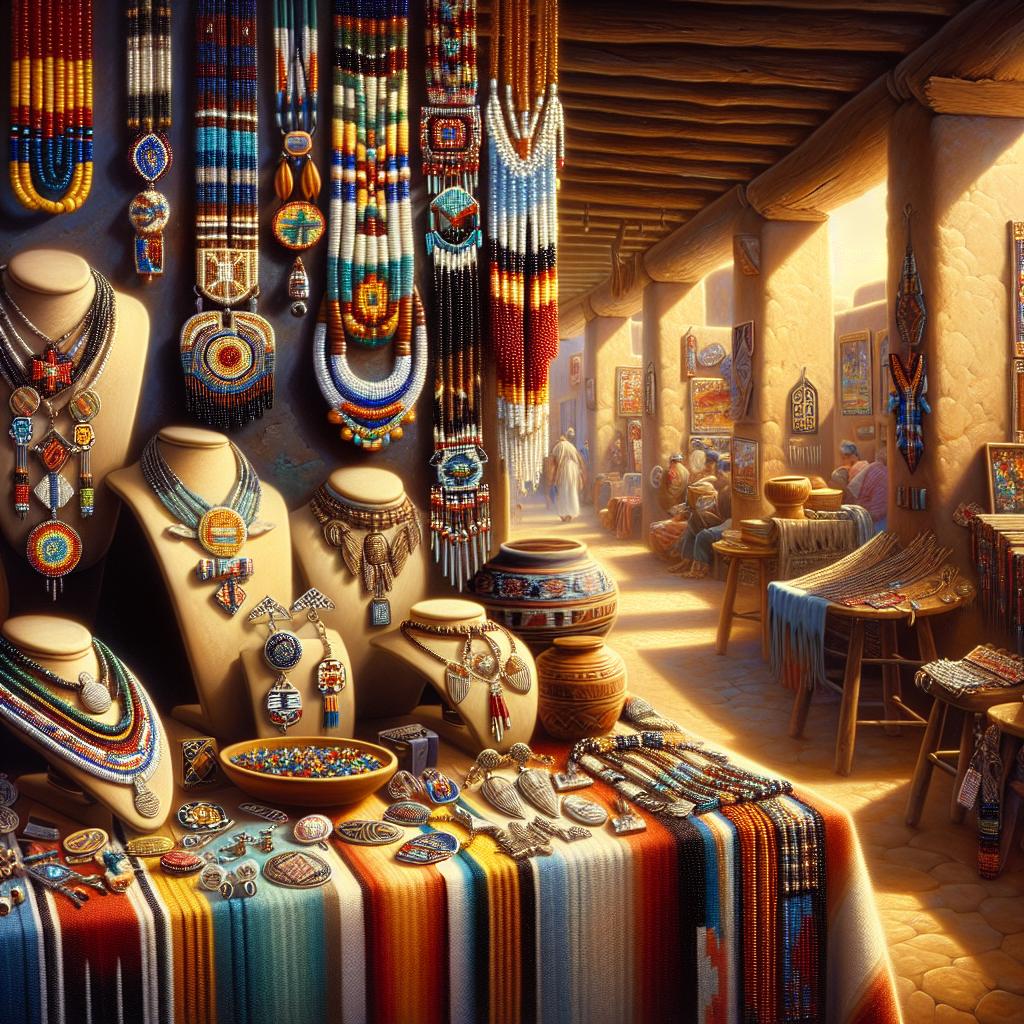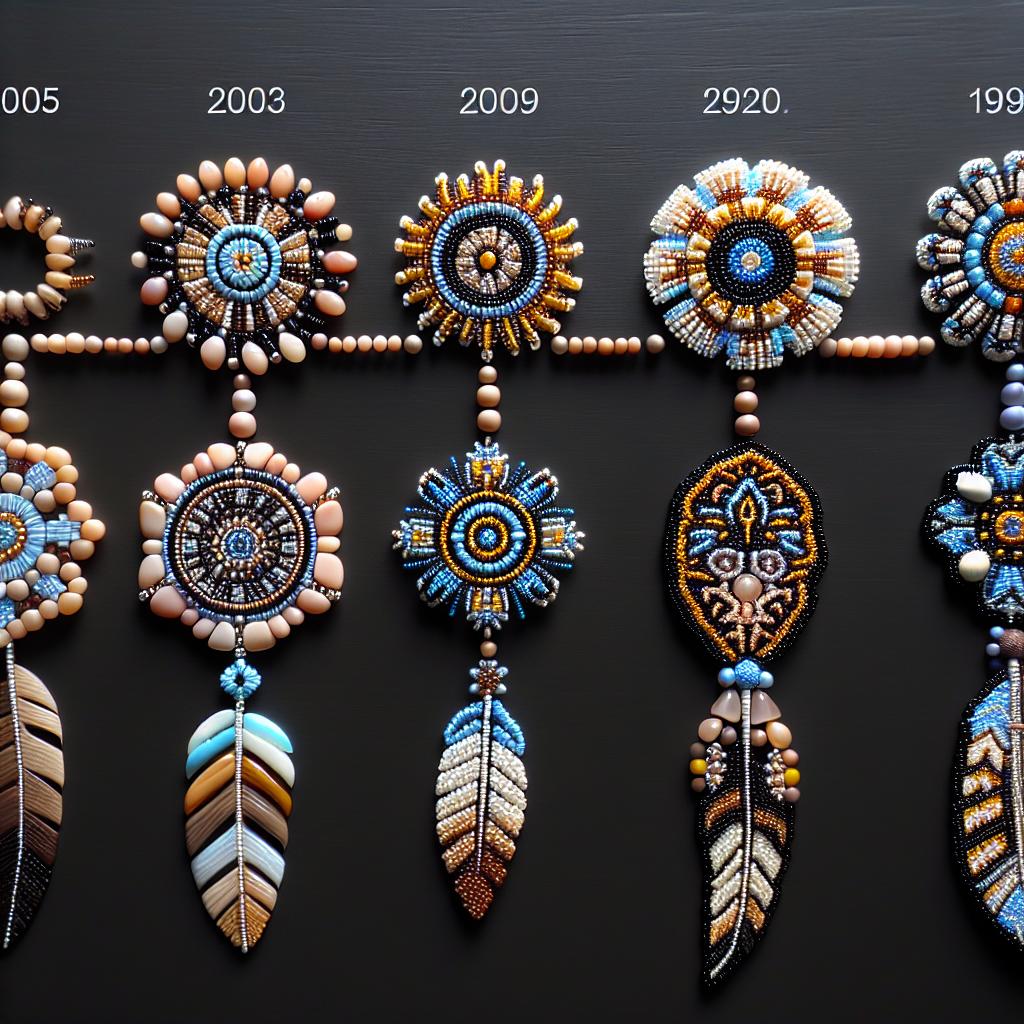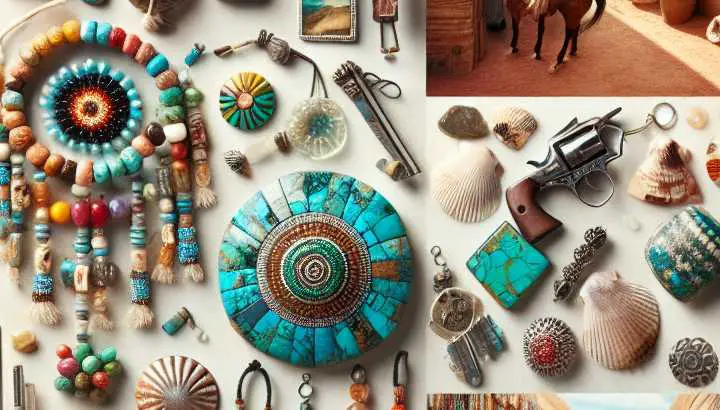The History of Beadwork in Southwestern Jewelry

1. Beadwork techniques of Native American tribes in Southwest
Title: Bedazzling Beads: An Eccentric Journey into Native American Beadwork in the Southwest
Grab your explorer hat and binoculars, folks! Are you ready to unravel the technicolor magic of Southwest Native American beadwork techniques? We hope so, because we’re going on an enticing journey through time, filled with radiant beads, unrivaled craftsmanship and dash of wit.
First, let’s paint the scene. Picture the Southwest: arid landscapes, fierce deserts, dramatic canyon vistas with a backdrop of brilliant sunsets. Now, imagine being in that sprawling wilderness with just one survival tool – beads. Sounds absurd, right? But for centuries, the Native American tribes in this region have crafted stories, history, and unmatched beauty with these teensy beads, relying on intricate beadwork techniques that make Da Vinci’s finest work seem like a kindergartener’s drawing.
Native American tribes such as the Hopi, Zuni, and Navajo have honed their beadwork techniques over centuries, using them to embellish clothing, jewelry, and ceremonial items. Just imagine a glimmering turquoise bead dancing in the sun, invoking the spirit of the glistening Southwest skies. Or picture the bold hues of red beads recalling the fiery voyages across the scorching deserts. These vivid beads were more than just accessories; they were storytelling masterpieces.
Let’s wind back the clock and check out some of these beadworking techniques. Think of them as the Sorcerer’s spells which magically transform ho-hum beads into objects of unmitigated allure.
1. Loom Beading: Imagine a tiny loom, about the size of your wristwatch, methodically harnessing bead after bead to create astounding patterns. The indigenous artisans persuaded these looms to bring forth complex geometric designs, and the resultant beadwork was often used to trim traditional wear.
2. Embroidery Beading: The Navajo and the Pueblo tribes are famous for this technique.
“Day by day their scattered tribes, then whole clans, broke up the tents of home and departed on the long mysterious exile”
~ Fiona
Macleod, Where the forest murmurs
Using a scary-looking-but-totally-harmless needle, the crafters would skilfully sew beads onto moccasins, belts, and pouches. Here, the canvas was the leather and the artist’s palette, a beautiful blend of colorful beads.
3. Stringing: It sounds simple – beads threaded onto a cord or wire – but requires the precision of a surgeon and the patience of a saint. Necklaces, rosaries and headdresses crafted in this way were worn during tribal ceremonies and festivities, and they looked utterly bewitching.
Every piece of Native American beadwork teems with life, reflecting the spirit of the land and its people. It’s as mesmerizing as trying to count the stars while camping in the wilderness, a tantalizing math problem that leaves you dizzy but utterly captivated.
If you’re asking, “Where, oh where, can I learn these stunning techniques?”, fear not. Several cultural organizations and art schools offer courses in Native American beadwork. But beware, one glimpse at these shimmery masterpieces will transform you into a bead addict, hopelessly captivated by the sparkle and the stories each bead hides.
Overall, the beadwork techniques of Southwest Native American tribes remind us that beauty often lies in plain sight. There is something profoundly dazzling about turning the ordinary – mundane beads – into extraordinary keepsakes that resonate with cultural significance. It’s a bit like discovering that your office-totaled coffee has the potential to transform into a creamy, dreamy latte.
So, next time you find a piece of beadwork, remember that there’s more to its sparkling aesthetic. Each bead has braved the journey through time, chronicling tales of survival, innovation, and legacy. Just imagine, if beads could talk, the stories they would tell!
Now, isn’t that something truly bead-azzling?
Enjoyed This? Here’s More: 1. Beadwork Techniques Of Native American Tribes In Southwest

2. Influence of Spanish on Southwestern beadwork jewelry
Title: “A Fiesta for the Eyes: The Colorful Influence of Spanish on Southwestern Beadwork Jewelry”
Before we dive into the dizzyingly brilliant world of Southwestern beadwork jewelry, let’s talk burritos. Yes, you heard that right, burritos, those deliciously stuffed tortilla rolls replete with spicy goodiness. Perfectly crafted, each bite is a mouthful of melting multi-cultural elements that create a unique flavor, and that’s precisely the kind of confluence we are discussing here – the appealing amalgamation of Spanish influences on traditional Southwestern beadwork jewelry.
Like that extra sprinkle of melted queso that elevates your burrito from yum to ‘can-I-have-one-more-please’ status, Spanish influence has brought a new shazam and pizzazz to Southwestern beadwork jewelry. So lavish and ornate in its original nature, the Spanish style studded these indigenous designs with an extra dash of sparkle, much like hot salsa on your taco.
Buckle up, folks, because we’re embarking on a colorful, bead-inspired journey through a remarkably vibrant culture clash that’s both delightful and oh-so-stunning.
It all begins with a tale older than your abuela’s best kept recipes. Back in the sixteenth century, when Spanish explorers strolled into Southwestern lands with a ‘hey neighbor’ attitude, they brought not only their grand tales of El Dorado but also their rich culture, the essence of which permeated into Southwestern beadwork jewelry.
Now, Southwestern tribes such as the Navajo, Zuni, and Hopi already had their inimitable styles. Navajo pieces, for example, echoed the surrounding desert floor’s rugged beauty, usually featuring turquoise that appeared as cool blue lakes amidst parched sands. Zuni designs, on the other hand, were like vibrant serapes that exploded in colors, flourished with excellent lapidary work. Meanwhile, the Hopi tribe impressed with their distinctive silver overlay techniques and geometrical designs.
Then, Spanish influence cha-cha-cha’ed its way into this party.
“They sang in the cause of education, the money earned by the recitals going to defray the expenses of erecting the $100,000 Jubilee Hall at Fisk University, Nashville, Tenn. An uncle of Mrs. Caldwell, Col. James L. Beck, commanded the Twenty-third regiment of colored Kansas volunteers which served in Cuba during the Spanish-American war”
~ Sheffield Ingalls, Atchison County Kansas
Much like a flamenco dancer, with her swirling skirts, staccato rhythms, and flashy footwork, Spanish additions were anything but subtle. It spun tradition around and infused a sparkle of extravagance.
Spanish influence, you see, came dressed in ornate designs, boasting rich filigree work that resembled the intricate ironworks of Andalusian balconies. It brought with it clusters of colorful gemstones that rivaled the lively hues of a Spanish fiesta. The Southwestern beadwork, traditionally subdued and earthy, found itself dancing in the limelight, donned in the flamboyant flair of Spanish vibrancy.
This blend resulted in a visual spectacle that’s hard to ignore. Imagine donning a necklace, a choker so intricately designed, peppered with beads and trinkets that each carry tales of ancestral art blending with Conquistador cultures. Look at it, imagine the Spanish sunsets, the arid Southwestern deserts, and voila, you have an art piece right at your collarbones!
And there’s perhaps no better example of this dazzling cultural fiesta than the Squash Blossom necklace. A classic example of Nuevomexicano jewelry, it’s a delightful mish-mash of the Spanish crescent-shaped “naja” pendant and the Native American handmade beads, the “squash blossoms.” And the result? Treasures that gleam with the glamor of Spain and resonate with the earthy whispers of the Southwest.
Spanish influence on Southwestern beadwork jewelry is most certainly like adding jalapenos to your guacamole – it’s explosive, makes your eyes water perhaps, but boy does it pack a punch of flavor. Beyond aesthetics, the shared legacy of these two vibrant cultures finds a testament in these beautifully designed pieces, making them not just fashion statements, but meaningful emblems of a colorful confluence.
Learn More: 2. Influence Of Spanish On Southwestern Beadwork Jewelry

3. Evolution of beadwork designs in Southwestern jewelry
Title: ‘Where there’s a Bead, there’s a Way: The Evolution of Beadwork Designs in Southwestern Jewelry’
Once upon a time in the Southwest, there were people who shared a story about a mythical crawly called the “bead spider”. Legend goes, this creature had an insanely meticulous task: toying around with brightly colored grains of sand, day in, day out, etching unimaginably intricate designs on them that would have made Michelangelo spit out his espresso in artistic envy. Those are, of course, our good old beads – the ostentatious protagonists of the Southwest Jewelry narrative that we are about to embark upon.
The epoch of beads in the Southwest traces back to prehistoric times, when the ancestral Puebloans realized that alongside warding off the hair from their face, shards of abalone shell strung on yucca twine could be used to create visually appealing patterns as well. Thus, “beadwork,” was born – albeit a bit rough around the edges, with jagged stones and shells strangling plant fiber cords. But hey, Rome wasn’t built in a day!
Soon enough, the humble bead evolved, taking a ‘turquoise’ turn. The Navajo, Hopi, and Pueblo tribes discovered the turquoise stone that symbolized health, prosperity, and protection. They traded their soul and maybe a few goats to procure this azure gemstone, and from there began the love story of turquoise and beadwork.
If you’ve seen turquoise beads, you’d know that their enchanting beauty is enough to make the most stoic and stiff upper-lipped Englishman break into an impromptu ballet twirl. Not your image of delightful insanity? Well, no worries. Back in the Southwest, this luminous blue-green hued stone became an integral part of the indigenous jewelry, blessing countless necklaces, bracelets, and earrings with its celestial allure.
In around the 1800s, Europeans rolled into town with glass and metal. Rather than shrugging off these alien materials as “ invaders’ quality”, the adaptive artisans of the Southwest saw an opportunity to introduce more color and variety.
“Later in date are a red ware and a black ware with rude geometrical incised designs, imitating basketwork, and with the incised lines filled in with white”
~ L.W., History Of Egypt, Chaldea, Syria, Babylonia, And Assyria In The Light Of Recent Discovery
Thus, beadwork started to sparkle and gleam with new vitality as the artists embraced these materials, incorporating glass seed beads and silver accents into their creations.
The turn of the 20th century witnessed the Southwest native tribes further fine-tuning their beadwork skills. They skillfully manipulated these petite orbs into a variety of designs, forming geometric patterns, stylized representations of animals, and other symbols, all of which whispered stories of their culture, beliefs, and life.
Fast forward to today, and beadwork in Southwestern jewelry has become a world renowned art. It comes beaming with a kaleidoscope of vivid hues, delicate textures, and enchanting patterns. From the intricate embroidery on Huichol beaded masks, to the vibrant Pop-Art displays on Zuni beadwork, each piece is a beautiful testament to the journey of this artwork.
The complex history of Southwestern beads mirrors the hard, relentless, and often thorny beats of evolution. Yet, throughout the ages, beadwork design has only grown more refined, colorful and extravagant, just like a fine wine – Chateau Bead, a collectible vintage for the art connoisseurs!
So the next time you’re primping in front of your mirror, donning that extravagant bead necklace, remember the tale of the bead spider and the ages of transformation each bead whispers. It’s not just a piece of jewelry, but a badge of history, resilience, and evolution.
And who knows, just like the bold Southwestern tribes, you too might discover that with the right bead, every fashion ensemble is possible!
Source: 3. Evolution Of Beadwork Designs In Southwestern Jewelry
